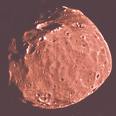
Phobos - NASA Viking Orbiter
Mars has two moons, Phobos and Deimos, that are both very small and irregular in shape. They orbit quite close to the planet, and Phobos, the inner and larger moon, has the distinction of being the only natural satellite in the solar system that orbits its planet in less time than it takes the planet to rotate about its axis.

Because of their small size, they were discovered only a little over a century ago. They are both very dark objects, covered in craters and possibly many metres of fine dust. However, strangest of all is the apparent knowledge of their existence 150 years before they were discovered!
2 DISCOVERY
The English Astronomer William Herschal made an unsuccessful search for satellites of Mars in 1783. His renown was such that many astronomers were thereby convinced that Mars had no moons.
A very careful search was conducted in 1864 at the Copenhagen Observatory by H L d'Arrest. However, he was no more succesful than was Herschal. It was not until 1877 that the two moons of Mars were discovered by Asaph Hall at the US Naval Observatory in Washington DC, USA. The outer satellite was discovered on August 11th and the inner one on August 17th. The telecope used by Hall for his discoveries was a 26- inch refractor.
3 NAMING
In the words of Asaph Hall, "Of the various names that have been proposed for these satellites, I have chosen those suggested by Mr Madan of Eton, England, viz: Deimos for the outer satellite; Phobos for the inner satellite. These are generally the names of the horses that draw the chariot of Mars; but in the lines referred to [in the 15th book of the Iliad] they are personified by Homer, and mean the attendants, or sons of Mars {the god of war}."
The Greek word phobos means fear. The English word phobia is derived from this. Deimos is translated terror, or sometimes flight. It is thus easy to remember the order of these moons. Phobos is the inner moon, Deimos the outer. When fear is close, flight takes you further away.
4 DESCRIPTION
The moons of Mars are so small that no detail can be seen with an Earth based telescope. It was not until 1971 that the US Mariner 9 spacecraft obtained the first images to show surface detail. Both moons are irregular in shape, and have surfaces that are pockmarked by many craters.
Phobos is the larger of the two moons and is roughly an ellipsoid 19.2 x 21.4 x 27.0 km across its 3 axes. Deimos is about 11 x 12 x 15 km.
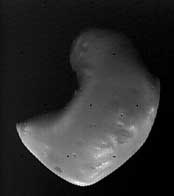 Deimos Viking 1 Orbiter NASA |
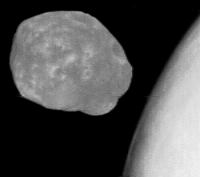 Phobos orbiting above Mars Image from Russian Phobos 2 spacecraft |
The surface of Phobos shows many sharp, uneroded craters of all sizes together with a vast network of linear features. These grooves are many kilometres long and hundreds of metres wide. They appear to be surface fractures associated with a very large (in comparison to the moon) crater called Stickney. This crater is 10 km in diameter and it dominates the moon's topography.
Both moons have crater densities comparable to the lunar uplands, and this suggests an age of a few billion years for each body.
5 ORIGIN
The irregular shapes of the moons and their heavy cratering shows that they have had a history of collisions and possibly fragmentation with other bodies.
Several theories have been proposed for their origin. One belief is that these moons are asteroids that have been gravitationally captured by Mars. Another is that they are fragments of an original larger Martian satellite that was struck and fragmented by an asteroid, the other pieces having escaped the Martian gravitational field. It appears unlikely that they could have simply grown from an orderly accumulation of many small grains of an original solar nebulae.
Sample return missions from both Mars and its moons are needed to resolve this issue.
6 ORBITS
Both moons orbit quite close to Mars. Phobos, in fact, lies just outside the Roche limit (that radius below which a gravitational-adhesive bound body may break up due to tidal forces induced by the primary). It is believed that there may well be significant internal movements of Phobos caused by tidal forces exerted on the moon by Mars. These could be measured by a seismometer placed on the surface.
The orbital parameters are given in the table below:
| Parameter | PHOBOS | DEIMOS | ||||||||||||||||||||||||||||||||
|---|---|---|---|---|---|---|---|---|---|---|---|---|---|---|---|---|---|---|---|---|---|---|---|---|---|---|---|---|---|---|---|---|---|---|
| Semimajor axis (km) | 9380 | 23500 | ||||||||||||||||||||||||||||||||
| Mean altitude (km) | 6000 | 20000 | ||||||||||||||||||||||||||||||||
| Sidereal period (hours) | 7.65 | 30.3 | ||||||||||||||||||||||||||||||||
| Orbit eccentricity | 0.018 | 0.002 | ||||||||||||||||||||||||||||||||
| Orbit inclination (deg) | 1.0 | 2.0 | ||||||||||||||||||||||||||||||||
| Rotational period (hr) | 7.65 | 30.3 | ||||||||||||||||||||||||||||||||
| Height | Velocity | Period |
|---|---|---|
| (km) | (km/s) | (mins) | 450 | 3.3 | 120.4 [Mars Global Surveyor orbit] | 1000 | 3.13 | 147.2 | 3000 | 2.59 | 258.3 | 6000 | 2.14 | 460.0 [Orbit of Phobos] | 9000 | 1.86 | 697.2 | 12000 | 1.67 | 965.0 | 15000 | 1.53 | 1260.5 | 17000 | 1.45 | 1471.6 [Areosynchronous orbit period = 1477.4 mins] | 20000 | 1.36 | 1807.9 [Orbit of Deimos] |
Both moons have rotation periods that are locked to their orbital motion. This means they continually present the same face to Mars (as our Moon does to the Earth). The long axis of each moon points toward Mars. This is due to gravity gradient stabilisation (the same phenomenon is sometimes used to stabilize low Earth orbiting satellites - using a long "gravity gradient" boom).
And finally, it is now known that the orbit of Phobos is slowly decaying - coming closer to Mars - and its expected lifetime is about 50 million years. Atmospheric drag should make the last part of its de-orbit fairly rapid.
7 PROPERTIES
Not a great deal is known about the properties of these two small moons. For several decades the Viking Orbiters provided the best images of the martian moons. However, recent missions such as the US Mars Global Surveyor and the European Mars Express have added both images and data to our knowledge.
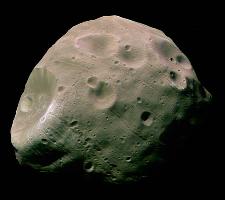 |
Phobos as seen by the European Space Agency
Mars Express mission. Craters cover the surface of
the moon, some with diameters that are substantial
fractions of the moon's size. The largest crater is
called Stickney. ESA image |
The surfaces of both Phobos and Deimos are very dark. This is seen by examining the albedo of several planets and moons in the solar system.
|
|
Of all the planets, Venus has the highest albedo due to its cloud cover. Phobos and Deimos, on the other hand are the darkest bodies (with the exception of some asteroids) in the solar system. It is no wonder they were so hard to find!
The low albedo is probably due both to the composition - it is believed that both moons are similar to carbonaceous chondrite meteorites - and the pulverisation of this material by countless surface meteoroid impacts. The regolith (surface covering rock) may consist of a good depth of fine carbon-like material.
The table below gives estimated masses, and average surface gravities.
| Parameter | PHOBOS | DEIMOS |
|---|---|---|
| Mass of moon (kg) | 9.6E15 | 2.0E15 |
| Density (kg/m^3) | 1900 | 2100 |
| Mean radius (km) | 11 | 6 |
| Surface gravity (m/s/s) | 0.005 | 0.004 (g/Earth=9.8) |
| Escape velocity (km/hr) | 40 | 25 |
8 THE VIEW FROM MARS
It is not the sidereal period of a satellite, but its synodic period that is important when observing from the planet's surface. This is the time between two successive appearances of the moon at the same place in the sky (for example between successive moonrises or moonsets). For Phobos this time is 11.1 hours. Thus you would see two moonrises and two moonsets on most Martian days (sometimes you may see three). Because this moon is below Areosynchronous orbit, it will rise in the west and set in the east.
Deimos moves much more slowly in the sky. Because it is just above Areosynchronous orbit, it has a period only a few hours longer than the rotational period of Mars. It will rise in the east, move slowly across the sky and set in the west a little over 2.5 days latter. It will rise again in 5.5 days, its synodic period.
Even though the moons of Mars are much closer to their primary (ie Mars) than is our Moon to the Earth, their small size still makes them appear smaller in the Martian sky than does the Moon in our sky. When overhead, Phobos subtends an angle of 11 minutes of arc which is only about one third of the Moon as seen from Earth. Another difference is that this angle varies as Phobos moves across the sky. When rising or setting, this moon subtends only 8 minutes of arc to an observer on the equator. This is a 30% reduction in the size it shows at the zenith. It is interesting to speculate that because of the pyschological illusion of increased size near the horizons (where the eye has a reference of comparison), the physical size reduction may go largely unnoticed.
 |
In this image taken by the Mars Exploration Rover
'Spirit' from the surface of Mars, Phobos and Deimos
are seen in the night sky close to one another, illustrating
their relative brightness. NASA/JPL image |
Deimos, which is not only smaller physically, but also further away, will appear as barely more than a bright star with an angular diameter of 2 minutes of arc when overhead at the equator. This is only twice the angle subtended by Venus at its closest approach to Earth. The variation in size as Deimos moves across the sky will be rather smaller than for Phobos.
The irregular shape of Phobos will be clearly apparent from Mars, but that of Deimos may be barely noticed. That is, Phobos will clearly be non-circular, but Deimos will barely be perceived as a disk with no visible structure.
The fact that both moons have very low inclination orbits means that they will not be visible from higher latitudes. Phobos will not be visible at latitudes above about 70 degrees, nor Deimos above about 83 degrees.
The low inclination of the moon orbits also means that they will often pass into the shadow of Mars. Such moon eclipses will occur about 1400 times for Phobos and 130 times for Deimos each Martian year (about 687 Earth days). There are also a similar number of solar transits each year. Neither moon subtends a large enough angle to eclipse the sun, even though the sun subtends a smaller angle from Mars than it does from the Earth. The sun appears about two thirds of the size it does from Earth (21 minutes of arc). Phobos appears about one half this size and Deimos about one tenth.
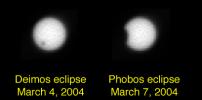 |
Two eclipse images taken by the Mars Exploration Rover
'Spirit' from the surface of Mars, show the size of the two
moons relative to the Sun. NASA/JPL image |
9 A MYSTERY?
In 1726 the British author Jonathon Swift wrote a satirical book called 'Gulliver's Travels'. In this work, Swift wrote that the inhabitants of Laputa had discovered two satellites that revolve around Mars. Not content with this, Swift even specified the orbital radius and periods of these moons as follows:
| Inner Moon | Outer Moon | |||
| (Swift) / | (Actual) | (Swift) / | (Actual) | |
| Radius (Mars Diameters) | 3 | 1.38 | 5 | 3.46 |
| Revolution period (hrs) | 10 | 7.7 | 21.5 | 30.3 |
However, as amazing as this may seem at first glance, a detailed analysis shows that Swift's choices are quite in accord with the available scientific knowledge of the day.
In 1610, following Galileo's discovery of 4 moons around Jupiter, Kepler speculated that Mars would be found to have 2 moons. He based this on observations that in proceeding out from the Sun, Venus had no moons, Earth one, Mars two, the "missing" planet three, and Jupiter four. This belief would have been strengthened in Swift's time, as by then five moons had been discovered around Saturn.
If we look at the orbital radii of the moons of Jupiter, we might see why Swift chose the orbits he did for the Martian moons.
| Moon 1 (Io) | 2.9 (rounds to Swift's value of 3) |
| Moon 2 (Europa) | 4.7 (rounds to Swift's value of 5) |
| Moon 3 (Ganymede) | 7.4 (N/A) |
| Moon 4 (Callisto) | 13.1 (N/A) |
 |
Once the orbital radius is given then Kepler's or Newton's laws may be called upon to compute the period. Two quantities are needed for this calculation - the diameter of Mars and its mass (or alternatively Kepler's constant for Mars). The first quantity was known (although it was believed to be 7700 km). It appears that Swift assumed an Earth mass, as this gives the figures he quoted. And so we see that maybe the "mystery" is not so mysterious after all. Some people have stated that Swift could not possibly have performed the required calculations. This may be so. But he undoubtedly had friends who could! |